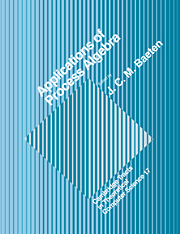Book contents
- Frontmatter
- Preface
- Contents
- An introduction to process algebra
- Two simple protocols
- Proving mutual exclusion with process algebra
- Process algebra as a tool for the specification and verification of CIM-architectures
- A process creation mechanism in process algebra
- Correctness proofs for systolic algorithms: palindromes and sorting
- Verification of an algorithm for log-time sorting by square comparison
- On the Amoeba protocol
- Process algebra semantics of POOL
- Some observations on redundancy in a context
- A modular approach to protocol verification using process algebra
- Index of concepts
- Index of names
- Index of symbols and notation
Process algebra as a tool for the specification and verification of CIM-architectures
Published online by Cambridge University Press: 03 December 2009
- Frontmatter
- Preface
- Contents
- An introduction to process algebra
- Two simple protocols
- Proving mutual exclusion with process algebra
- Process algebra as a tool for the specification and verification of CIM-architectures
- A process creation mechanism in process algebra
- Correctness proofs for systolic algorithms: palindromes and sorting
- Verification of an algorithm for log-time sorting by square comparison
- On the Amoeba protocol
- Process algebra semantics of POOL
- Some observations on redundancy in a context
- A modular approach to protocol verification using process algebra
- Index of concepts
- Index of names
- Index of symbols and notation
Summary
Flexibility of a manufacturing system implies that it must be possible to reorganize the configuration of the system's components efficiently and correctly. To avoid costly redesign, we have the need for a formal description technique for specifying the (co)operation of the components. Process algebra – a theory for concurrency – will be shown to be expressive enough to specify, and even verify, the correct functioning of such a system. This will be demonstrated by formally specifying and verifying two workcells, which can be viewed as units of a small number of cooperating machines.
INTRODUCTION
One can speak of Computer Integrated Manufacturing (CIM) if the computer is used in all phases of the production of some industrial product. In this paper we will focus on the design of the product-flow and the information-flow, which occurs when products are actually produced. Topics like product-development, marketing and management are beyond the scope of this paper. The technique used in this paper is based on a theory for concurrency, called process algebra (see or). It can be used to describe the total phase of manufacturing, from the ordering of raw materials up to the shipping of the products which are made from this materials. During this process many machines are used, which can operate independently, but often depend on the correct operation of each other. Providing a correct functioning of the total of all machines, computers and transport-services is not a trivial exercise. Before actually building such a system (a CIM-architecture) there must be some design. Such a specification, when validated, describes a properly functioning system.
- Type
- Chapter
- Information
- Applications of Process Algebra , pp. 53 - 80Publisher: Cambridge University PressPrint publication year: 1990

